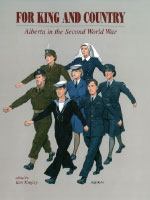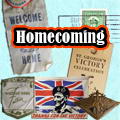Home | Resources | For King and Country | Introduction
Introduction
Ken Tingley
 Copyright © 1995 Provincial Museum of Alberta
Copyright © 1995 Provincial Museum of Alberta
Edited by Ken Tingley
364 pages - Over 166 B&W; photos, foreword, preface, acknowledgements and individual article footnotes and bibliographies,
8 1/2'' x 11 1/2'', out of print, ISBN 1-895073-81-2.
Nineteen ninety-five marks the fiftieth anniversary of the end of the Second World War. Victory in Europe Day (VE Day) marked the formal end of the European conflict on 8 May 1945. On 15 August 1945, Victory over Japan Day (VJ Day) was celebrated throughout most Allied countries on the day following the Japanese acceptance of the terms of surrender. During that spring and summer, the growing realization that the world had been fundamentally changed swept through the global community. Shock at the atomic bomb attacks on Hiroshima and Nagasaki, revelations of the genocidal inhumanity perpetrated in the death camps of Eastern Europe, the horrendous casualty lists, and the massive dispersal of populations all symbolized the brutal nature of the war. At the same time, a sense of euphoria and optimism found expression among the returning veterans as they turned their energy toward postwar reconstruction and civil re-establishment. One thing was obvious to all, and that was that the world had changed. Certainly Canada had been changed by its wartime experience, and so had Alberta.
The Provincial Museum of Alberta [now the Royal Alberta Museum] is marking the end of the Second World War through a travelling exhibit which opened in Edmonton on 4 February 1995, and which will be seen in many Alberta communities. For King and Country: Alberta in the Second World War examines the many ways in which the war affected the people of Alberta, and shaped the society in which they lived. This book was published to complement the exhibit, and to allow several of those who served in uniform to communicate directly to the reader the nature of their experience. Every effort has been made to allow these men and women to speak in their own voice as they describe their experiences, with as little editorial interference as possible. Other articles were written to provide a context for such memoirs, and to define the wider historical circumstances within which the individual was swept up. The experiences of Albertans, both overseas and on the homefront, are examined, as are the experiences of those men, women, and children who became involved on the Alberta homefront as prisoners of war or evacuees.
Alberta's contribution to the war was significant. The facts presented in the exhibit speak eloquently of that contribution. Albertans served in every theatre of war, in such distinguished units as the Loyal Edmonton Regiment, Calgary Highlanders, King's Own Calgary Regiment, South Alberta Regiment, and Lord Strathcona's Horse (Royal Canadians). Of the 50,844 Albertans who served in the Canadian Army, many paid the supreme sacrifice or were wounded during the war. A surprising 22 per cent of the Royal Canadian Navy was recruited from the prairie provinces during the war. Alberta's two naval divisions accounted for a significant number of these: HMCS Nonsuch in Edmonton recruited 3588 sailors, while HMCS Tecumseh in Calgary recruited 3899. Many others enlisted in the Merchant Marine or in the Royal Navy. Alberta also contributed 19,499 men and women to the Royal Canadian Air Force, while the Royal Canadian Air Force (Women's Division) recruited additional provincial women into its ranks.
On the homefront, the most immediately visible effects of the war came with the British Commonwealth Air Training Plan (BCATP) facilities built rapidly across Alberta to provide the highly trained technicians and aircrews needed for the modern Allied air forces. Flying Instructors' Schools were located in Vulcan and Pearce; Flying Training Schools in Calgary, Fort Macleod, Claresholm, Vulcan, Medicine Hat, and Penhold; Bombing and Gunnery Schools in Lethbridge; Air Observer Schools in Edmonton and Pearce; and Elementary Flying Training Schools in Lethbridge, High River, Edmonton, De Winton, Bowden and Pearce.
In addition to the BCATP, the "friendly invasion" of American construction and service personnel following the Japanese attack on Pearl Harbor on 7 December 1941 was responsible for a massive impact on many areas of the province. This was especially true of Edmonton, which became the supply, communications, and transportation centre for the three most significant projects designed to ensure northwestern continental defence. The Alaska Highway, Northwest Staging Route, and Canol Pipeline Project all emanated from Edmonton, which truly lived up to its sobriquet "Gateway to the North" as the armies of engineers, technicians, and construction workers were funnelled through on their way to Alaska. During peak activity, over 33,000 Americans could be found in Alberta, northeastern British Columbia, and the Yukon Territory.
When Maurice Doll, Curator of Government History at the Provincial Museum of Alberta [now the Royal Alberta Museum], approached me to edit a book which would contain articles reflecting aspects of the Alberta wartime experience, I had some concern that it might prove difficult to find enough material to cover this fairly broad subject. Articles which already had been completed, or almost completed, were required to accommodate the looming deadline. However, we were pleasantly surprised to find a number of veterans who were prepared to write accounts of their experiences, as well as many historians and researchers who already were involved in research, or completing projects dealing with a wartime theme. This was particularly true of several aspects of social history associated with the Alberta homefront. Finally, the book presents an overview of Alberta during the Second World War as seen from various perspectives and reflects the numerous and sometimes divergent ways in which this complex series of events was experienced.
Albertans who served their country overseas are represented by several writers. Harris Field recounts his experiences with the Edmonton Regiment in Italy and takes the reader on a night patrol. Dr. David Lewis brings an immediacy to his account of the infamous Dieppe Raid in which most of the 2nd Canadian Division was killed, wounded, or captured in August 1942. Miss Jessie Morrison gives a moving account of her time with the No. 10 Canadian General Hospital near Bayeux, France following the D-Day landing of 6 June 1944. Rodney Pike takes the reader on dangerous and vital convoy duty along the North Atlantic shipping lanes. Stan Reynolds describes his education as an RCAF pilot, while Phyllis Patterson evokes the feelings of a young prairie woman who enlists in the RCAF (WD).
The military accomplishments of the Calgary Highlanders at the Walcheren Causeway, during the Battle of the Scheldt Estuary in The Netherlands, is meticulously detailed by Dr. David Bercuson, who recently published Battalion of Heroes: The Calgary Highlanders in World War II. Donna Zwicker describes recruitment among Alberta women for the Canadian Women's Army Corps, RCAF(WD) and "Wrens." James Dempsey, Director of the School of Native Studies at the University of Alberta, assesses the effect upon the province's native community of their recruitment into the armed forces and their experiences in uniform. Carrielynn Lamouche also provides an appreciation of the Métis men who served Canada in uniform.
Although Alberta was far from the major theatres of war, it nevertheless played a significant role in the global air war and continental defence. Dr. Carl Christie, Senior Researcher for National Defence Headquarters Directorate of History, places the Northwest Staging Route within its continental context, and indicates its importance to the Allied cause through Lend-Lease flights to the USSR, as well as its immediate impact on Alberta, and its more lasting influence upon international aviation. Mark Hopkins, Curator at the Alberta Aviation Museum, describes in more detail the overwhelming impact of the war upon the Edmonton Municipal Airport. Patricia Myers indicates the pervasive influence of the British Commonwealth Air Training Plan upon the urban centres, large and small, throughout Alberta. Frank Chiovelli also reveals a little-known aspect of the war, the Japanese balloon bomb offensive against North America during 1944 and 1945. Over two dozen balloon bombs were recovered in Alberta, while others drifted inland to central Canada during this campaign.
Most Alberta women found that their lives during wartime were changed in many ways. Some of these were immediate and obvious, and others more difficult to assess. Catherine Cooper Cole provides an account of women struggling to cope on the homefront while many of the men were serving in the armed forces. Donna Zwicker, in addition to her article on Alberta women in uniform, acknowledges the pervasive role women filled in volunteer war work at home. In many ways the women of Alberta "kept the home fires burning" during the six war years.
The social and economic impact of the war on Alberta communities was quite striking. Dr. David Leonard, Provincial Archivist of Alberta, describes the way popular culture changed in Edmonton between 1939 and 1945 and how these changes were accelerated during the "American occupation" of 1942–1945. Jeff Keshen, an SSHRC Postdoctoral Fellow at the University of Alberta who is studying the impact of the war on the "morals and morale" of the Canadian homefront, provides an absorbing account of wartime concerns in Alberta. Steven Boddington and Sean Moir give a valuable overview of the "friendly invasion" of Edmonton by Americans during major construction projects such as the Alaska Highway, Canol Pipeline Project, and Northwest Staging Route. Bob Oliphant, a commercial artist who worked in Edmonton at this time for Bechtel, Price Callahan, and Kansas City Bridge Company, gives a personal flavour to his memories of those days. Michael Dawe, Archivist for the Red Deer and District Museum and Archives, describes how the war came to Red Deer and changed it virtually overnight. Bruce Ibsen, City Archivist for the City of Edmonton Archives, writes an amusing account of wartime bureaucracy and injured civic pride, in which he answers the question, "Why was there no HMCS Edmonton?"
While most Albertans were drawn together by the war effort as they struggled toward a common goal, several groups and individuals experienced the war in ways which isolated them from their fellow Canadians. David Goa, Curator of Folklife at the Provincial Museum of Alberta, questions how the Japanese-Canadian community of southern Alberta could adapt to wartime and postwar conditions with so little animosity. He suggests that those who experienced the war as evacuees sent to work in the sugar beet fields near Lethbridge, Taber, and Picture Butte used Buddhist and Neo-Confucian beliefs to adapt in ways which allowed them to continue with their lives. John Kelly describes the Prisoner of War Camps in southern Alberta where German POWs were interned, while Dan Duda provides an account of the executions of August Plaszek and Karl Lehmann by the Gestapo group which dominated the internal operations of the Medicine Hat camp. Peter Melnycky writes a moving account of the Ukrainian-Canadian contribution to the war. My article indicates how the Veterans Volunteer Reserve perpetuated nativist sentiments formed among most of its members during the First World War, and how these were implemented in the "enemy alien" settlement blocs of Alberta. Finally, Dr. Reginald Roy, prominent Canadian military historian, provides an overview of Western Canada during the Second World War.
During the Second World War, Canada had a population of just over eleven million. Yet over a million Canadian men and women served in uniform between 1939 and 1945. Countless others served on the homefront in farm fields, munitions factories, and volunteer war services. By the end of the war, the RCAF was one of the largest air forces in the world, with personnel numbering over a quarter million; this was sufficient to operate an entire bomber group, No.6 Group. The Royal Canadian Navy became the fourth-largest in the world as it provided the corvettes and frigates for convoy duty in the Battle of the Atlantic. The Canadian Army distinguished itself from Dieppe to Normandy, from the Battle of the Scheldt Estuary to Italy. The British Commonwealth Air Training Plan has been judged by many historians to be the single greatest Canadian contribution to the Allied victory. Albertans participated in all these campaigns with distinction and their contributions were an important part of the war.
Many of us born after the Second World War experienced the events of that great violent upheaval through the lives of our close relatives, as I did through my father, Francis D. Tingley [RCAF 1940–1945] and father-in-law, Robert E. Whitson [RCAP 1941–1945]. Sometimes they told us about their experiences; more often they did not. Sometimes distorted views of wartime events came to us through the movies. We remembered on Remembrance Day. But as years passed and the wartime veterans became grandfathers or great-grandfathers, the memories of the young grew more vague and Remembrance Day memories less clear. This may be reason enough to recall the events of fifty years ago. By shaping our society, they still affect us all.








